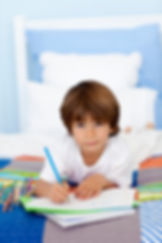What if the Tooth Fairy kills me in my sleep: An Anxiety story

I’m lying on the floor of a San Francisco ballet studio, clutching my 3-year-old daughter, Penelope, by the ankle, screaming, “I must be next to you at all times! I’m sorry, but you’ll just have to pirouette with me attached!”
Penelope can’t stop laughing, wrangles free and pushes me out the door.
I walk down the street, pleased with my performance of this daily comedy routine designed to help reduce my daughter’s anxiety.
A month earlier, Penelope had returned from preschool acutely distressed by “Miss Nelson Is Missing,” a book read aloud to her class. In the book, a teacher, Miss Nelson, disguises herself as a new teacher and a child wonders if Miss Nelson has been eaten by a shark.
Penelope asked, repeatedly, “What if you’re eaten by a shark?” Reassurance provided no relief. She refused to attend preschool or her beloved ballet class without me. She couldn’t be alone, day or night, in any room of our apartment. What-ifs multiplied: “What if the world is eaten and I’m the only one left?” “What if the ceiling falls?” “What if the tooth fairy kills me in my sleep?”
At one point she articulated, “This is a new feeling. Make it stop, Mom. I’m scared but it’s not ending.” And then: “Do you know this feeling?”
I certainly did. It had imprisoned me since, well, always. My father died unexpectedly when I was 10 months old and I grew up thinking life was about preventing tragedy. I hid obsessive-compulsive rituals from babysitters while scanning our New York City street for my mother’s orange hat, the all-clear signal that she was safely returning from work.
“What if something happens to you?” became my mantra. “It won’t. Stop worrying, dear,” became hers, which only gave that what-if more leverage. Anxiety slowly embedded itself into my personality.
Decades of therapy later, pregnant and weaning myself off Klonopin, a new worry emerged: “What if my child inherits or picks up my anxiety?” I knew firsthand how anxiety could beat down a child and, by proxy, a mother, especially one whose own anxiety might have caused the spiral in the first place.
When Penelope was born, her nervous system, like mine, seemed sensitive. She shared an aversion to yippy dogs. But she never seemed anxious. When we stayed at a surprisingly large Airbnb on vacation, she even insisted, at age 2, on sleeping in her own wing. Suddenly, though, after listening to this book, she begged for rescue from something I’d struggled to manage my whole life. I felt as if I were drowning in our combined mental anguish.
My pediatrician recommended a book called “The Opposite of Worry.” The preface reads, “Most approaches to childhood anxiety leave parents out … that’s a big mistake … this book puts parenting at the center. You may also find help for your own anxiety — if by chance you have any.”
The author, Dr. Lawrence Cohen, prescribes parental play therapy for trauma, including humorous games and campy role reversals, which release nervous tension through laughter, without mocking it. He offers whimsical techniques to help children see themselves as separate from their thoughts.
Happy to tap into my underutilized talent for slapstick, I implemented one of his suggestions for fear around separation: Try becoming hilariously clingy at home. I panicked that Penelope might go to Montreal to join Cirque du Soleil as a ballet expert when she took a small step away from me. She was sufficiently amused and ran, threatening to practice a leap, as I chased her. She requested the game daily and then at drop-offs at school and ballet. At pickup time, she’d hide and I’d make frantic attempts to contact the prime minister of Canada — often in the presence of teachers and other parents assessing my mental stability and/or comedic timing.
I also pretended to be terrified of things Penelope would never fear, like her heart-patterned socks. She’d pull off her shoes, yelling, “Check. Out. These. Feet.” As I’d cower, she’d promise to hold my hand when approaching the hamper.
She designed a paper-bag puppet she named Feeeeer. “You’re being too loud,” she’d tell it. “Stop bossing me.” She described Feeeeer as “screechy — even more than grandma’s friend who wears too much makeup.”
In answer to many what-ifs, including “I know monsters don’t exist but just what if one came and bit me?,” we sang together: “We would get through it.”

Influenced by the book and my own therapy, we created a set of strategies starting with the letter B: Breathing. Body (feel sensations). Bubble (love is everywhere). Bus (imagine driving with Anxiety merely as a screechy passenger). Be (in the present moment). Boat (picture worry floating away).
Some days I felt in awe of my maternal ingenuity, others like I’d entered an exhausting, endless “Saturday Night Live” sketch.
One morning, two months later, Penelope said, “Mom, I don’t need to play that Montreal game anymore.” Her internal alarm had reset.
I worried, What if her anxiety returns? Then I gave the what-if a name: Horace. I drew his globular face on construction paper with crayons. I gave him a thick Jersey dialect. I did my “B’s” and chanted, “We would get through it.”
My alarm also reset — but not just because hers had. Not just because this approach had been effective on me. And not just because her bravery had been so inspiring. It reset mostly because the advice I’d been giving was directed at my reflection in a generational mirror.
By taking care of my anxious child I was finally able to start taking care of my anxious self.
Read original article here










